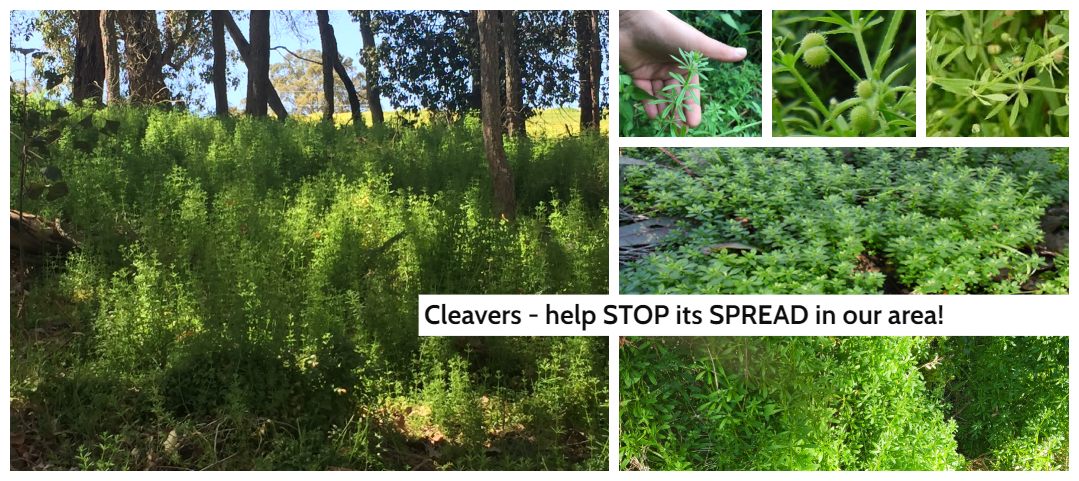Cleavers (Galium aparine) species is derived from the Greek word ‘clinging’ which is aptly named! The seed and leaves adhere to everything through micro hooks enabling the seed of Cleavers to disperse widely via sheep, kangaroos and King Gees. This highly invasive and problematic weed has been recorded in multiple shires within WA with most in the south-west.
Cleavers are rampant ramblers smothering out pasture, native vegetation and climbing into the canopy. Based on community reports and LBG field work, sighted Cleavers infestations within the Donnybrook-Balingup Shire, is largely limited to an understory species preferring shaded areas and fence lines. It has a habit of putting out an ‘insurance policy’ when young by producing a couple seeds before bolting to its mature height of up to 4m where it becomes a ladder fuel for fire.
The biosecurity status of Cleavers is that this C3 weed is considered established and widespread in many areas, having been introduced to WA via New Zealand Canola. This highly invasive plant, is designated as a priority declared pest in the Blackwood Basin, encompassing Balingup but not extending to the Preston or Capel catchments. In simple terms, if you emptied your rainwater gauge (unlikely now) and the water flows into the Blackwood River, which runs through areas supported by our neighbouring Blackwood Biosecurity Inc. (BBI). Currently, within the operational boundaries of the Leschenault Biosecurity Group (LBG), Cleavers has not been identified as a priority declared pest weed. However, it’s crucial to note that, as previously reported, the spread of this highly invasive, problematic weed is on the rise. To date, the LBG has collaborated with numerous landholders in the northern localities of the Shire of Donnybrook-Balingup, providing support for control measures. Despite not being classified as a priority declared pest within the LBG operational area, proactive efforts are imperative, considering our noted expansion of Cleavers in our area, including a couple of reports in the Shire of Dardanup.
Over the last two years, Cleavers have spread out of the Blackwood Basin and infested road transport routes which cannot be attributed to wildlife or livestock alone. The causative agent is likely linked to the rapid dispersal with hay cartage at 80km/h on open flatbed trucks. Cleavers are an annual and rely on seed production for their survival over the drier months which ripens in late spring when meadow hay is being cut and rolled from infected paddocks. Formal weed mapping has not occurred for this invasive weed but anecdotal evidence suggests that in the south: Newlands on the upper Capel, Brookhampton, Thompson Brook is heavy but manageable, to the West: Paynedale is clean, Argyle/Irishtown has multiple outbreaks as does the Ferguson Road in Lowden but further North into Dardanup is relatively unaffected and to the East the locality of Glen Mervyn is the last known outbreak of which LBG is aware.
Unfortunately, we have found that Cleavers also proliferate in a vacuum of non-management alongside the road reserve. Our understanding of current practices is that an annual herbicide treatment is applied to the road shoulder which is a strip approximately 1m wide ostensibly for road surface preservation. However, between the strip and the property fence line is ‘no man’s land’ and Cleaver seed is deposited there, often likely from mobile hay rolls.
What you can do to help stop the spread:
- Be aware of its presence and follow appropriate biosecurity practises (come in clean, go out clean), to minimise further spread (including management where possible).
- Try to avoid buying hay infected with Cleavers; prioritize obtaining hay from properties that have been vetted or where there is awareness and concern about potential Cleavers infestation.
- Ask your carting contractor to cover their loads
- Consider making a deputation to Shire Councils for increased funding to control Cleavers, where identified, beyond the typical 1-metre herbicide control area.
- Control Cleavers on private property particularly if your selling hay
- Reach out to the Leschenault Biosecurity Group or Blackwood Biosecurity for assistance
Why it matters:
- Highly invasive, competitive climbing plant
- Threat to agriculture and natural environment
- Forms dense masses of tangled vegetation in crops, along fence lines and in bushland
- Dense masses outcompete other plants
- Up to 4-metre vertical growth creates highly effective ladder fuel for fire. increasing challenges to bushfire control
- Easily spread through its ‘sticky’ hooks that stick to animals, birds, clothing, and machinery


Recent Comments